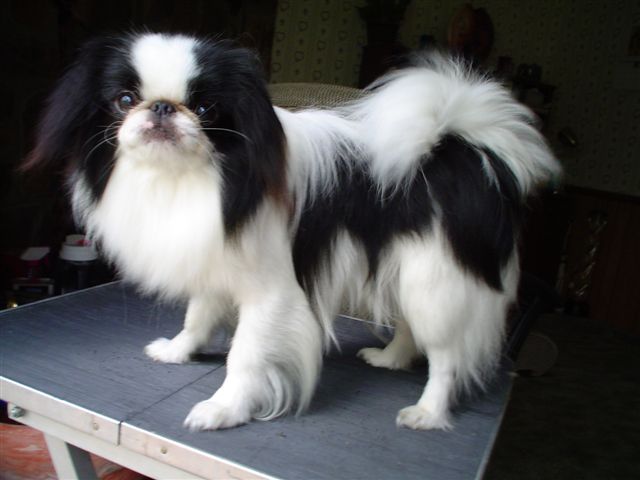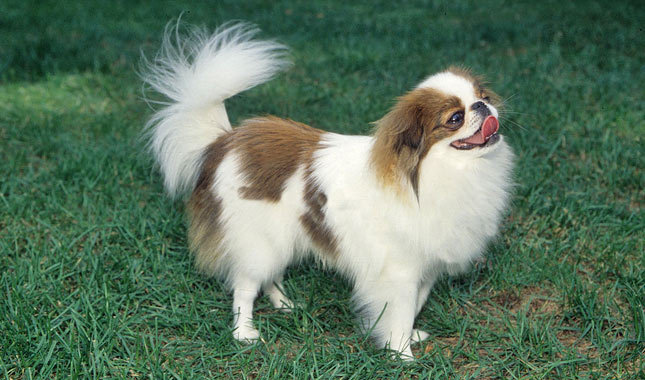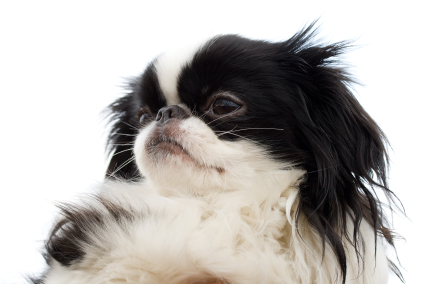
The Breed History
The chins were considered above regular dogs (inu) in status
because of their ancient origins with aristocracy in China. Perhaps
the Tibetan Spaniel was a breed ancestor. They were often given as
gifts to visiting dignitaries. It is thought that they were given to the
emperor of Japan perhaps in the 1700s, where they subsequently
became very popular and were then subsequently named the
Japanese Chin. In the 1800s some dogs were also given as gifts to
Queen Victoria. The AKC first registered the Japanese Chin breed in
1977 using that name rather than the previously applied American
designation: Japanese Spaniel (that had first entered the books in
1888). The CKC still retains Japanese Spaniel as the breed name.
English breeders are thought to have introduced some Cavalier King
Charles spaniel into the bloodlines.
Breeding for Function
Companionship has been the only function of the Japanese Chin.
Physical Characteristics
Height at Withers: 8-11" (20.5-28 cm)
Weight: 4-7 lb (2-3 kg), though some are up to 11 lb (5 kg)-the
larger body size is not preferred.
Coat: The single layered soft, silky, thick (profuse) coat is straight.
Most dogs are black and white, others are black and white with tan
points; other markings may include white with red, lemon, sable
and brindle. Markings on the face should be symmetrical-a blaze
is preferred, and other markings have a preferred distribution laid
out in the breed standard. Coat stands off, and ruff and trousers are
present though the head has short hair cover.
Longevity: 12-14 years
Points of Conformation: They possess a high head carriage,
square, solid and compact conformation. Movement is animated
and straight, and they are described as having an "Oriental"
expression. They have dark large eyes, the nose is matched to coat
color, and the very heavily plumed tail is carried over the back and
may be curved to either side. The muzzle is short, eyes are front
facing and widely set, the stop is pronounced, head is broad, and
the skull rounded. Note that a bit of white showing in the medial
canthus and around the edge of the cornea is considered desirable
in the breed. The small ears are triangular and hang beside the head
with copious feathering, and fine leather. The nose is upturned,
nostrils wide and it sits between the eyes. The bite is only slightly
off ideally. Neck is moderate in length, and muscling, topline is level,
and thorax is moderately deep and round. They have a high set tail.
The limbs are straight boned and dewclaw removal is optional. Feet
are feathered and hare shaped.
Recognized Behavior Issues and Traits
Reported breed characteristics include: Sensitive, friendly, alert
and active, tolerates temperature extremes well but should be
kept as a housedog. The Chin is generally reserved with strangers,
independent minded and even sometimes feisty. They are generally
not considered for other than urban or suburban pet and are well
suited to apartment life. They have low exercise and grooming
needs. They are considered to be somewhat like a cat, being very
clean and agile in climbing and jumping and in using their front
feet for grasping.
Normal Physiologic Variations
None reported
Drug Sensitivities
None reported
Inherited Diseases
Patella Luxation: Polygenically inherited laxity of patellar
ligaments, causing luxation, lameness, and later degenerative joint
disease. Treat surgically if causing clinical signs. Reported 4.8x odds
ratio versus other breeds. OFA reports 11.5% affected.
Hip Dysplasia and Legg-Calve Perthes Disease: Polygenically
inherited traits causing degenerative hip joint disease and arthritis.
OFA reports 8.3% affected.
Elbow Dysplasia: Polygenically inherited trait causing elbow
arthritis. Too few Japanese Chin have been screened by OFA to
determine an accurate frequency.
GM2 Gangliosidosis: A rare, autosomal recessive glycogen storage
disease causing neurological signs has been identified in young
Japanese Chin. The biochemical and histopathologic diagnosis is
GM2 gangliosidosis, with an increase in total beta-hexosaminidase
activity measured in vitro. A genetic test is available.
Disease Predispositions
Cataracts: Anterior, posterior, and equatorial cortex intermediate
and punctate cataracts predominate in the breed. Reported in
4.89% of Japanese Chin presented to veterinary teaching hospitals.
Identified in 12.27% of Japanese Chin CERF examined by veterinary
ophthalmologists between 2000-2005. CERF does not recommend
breeding any Japanese Chin with a cataract.
Persistent Pupillary Membranes: Strands of fetal remnant
connecting; iris to iris, cornea, lens, or involving sheets of tissue.
The later three forms can impair vision, and dogs affected with
these forms should not be bred. Identified in 11.19% of Japanese
Chin CERF examined by veterinary ophthalmologists between
2000-2005.
Hypothyroidism: Inherited autoimmune thyroiditis. 6.2% positive
for thyroid auto-antibodies based on testing at Michigan State
University. (Ave. for all breeds is 7.5%).
Entropion: Rolling in of the eyelid. Can cause corneal irritation or
ulceration. Entropion is reported in 5.42% of Japanese Chin CERF
examined by veterinary ophthalmologists between 2000-2005.
Distichiasis: Abnormally placed eyelashes that irritate the
cornea and conjunctiva. Can cause secondary corneal ulceration.
Identified in 5.05% of Japanese Chin CERF examined by veterinary
ophthalmologists between 2000-2005.
Persistent Hyaloid Artery: Congenital defect resulting from
abnormalities in the development and regression of the hyaloid
artery. Identified in 3.25% of Japanese Chin CERF examined by
veterinary ophthalmologists between 2000-2005.
Exposure Keratopathy Syndrome/Pigmentary Keratitis: Corneal
reactivity and drying from ocular exposure secondary to shallow
orbits, exophthalmos, and lagophthalmos. Identified in 2.53% of
Japanese Chin CERF examined by veterinary ophthalmologists
between 2000-2005.
Persistent Hyperplastic Tunica Vasculosa Lentis and Primary
Vitreous (PHTVL/PHPV): Congenital disorder presenting in the
breed with variable lesions from spots on the posterior lens to
posterior lenticonus, and posterior polar subcapsular cataracts.
Identified in 2.53% of Japanese Chin CERF examined by veterinary
ophthalmologists between 2000-2005.
Lens Luxation/Subluxation: Can be primary, or secondary.
Identified in 1.44% of Japanese Chin CERF examined by veterinary
ophthalmologists between 2000-2005.
Mitral Valve Disease (MVD): Japanese Chin dogs are prone to
early age mitral regurgitation. This condition may eventually lead
to congestive heart disease, cardiac arrhythmias and cardiac failure.
Unknown mode of inheritance. (See JCCA website)
Atlantoaxial Subluxation: Subluxation of the atlantoaxial
joint is seen at an increased frequency in the breed. It can occur
subsequent to a variety of lesions of the dens or atlantoaxial
ligaments. In each case, dorsal displacement of the axis results
in compression of the cervical spinal cord. Unknown mode of
inheritance.
Epilepsy and portosystemic (liver) shunts are reported in the breed.
Cryptorchidism, Elbow Luxation, Hemivertebra, and Progressive
Retinal Atrophy are reported.
Isolated Case Studies
None reported
Genetic Tests
Tests of Genotype: Direct test for coat colors is available from
HealthGene and VetGen.
Direct test for Gen2-gangliosidosis is available from the OFA.
Tests of Phenotype: CHIC Certification: Required testing includes
CERF eye examination (minimum 3 years of age), patella examination
(minimum 1 year), and cardiac evaluation (minimum 4 years by a
cardiologist). (See CHIC website; www.caninehealthinfo.org).
Recommended tests include hip and elbow radiographs, and thyroid
profile including autoantibodies.
Miscellaneous
- Breed name synonyms: Japanese Spaniel, Chin.
- Registries: AKC, UKC, CKC, KCGB (Kennel Club of Great Britain),
ANKC (Australian National Kennel Club), NKC (National Kennel Club).
- AKC rank (year 2008): 74 (1,066 dogs registered)
- Internet resources: Japanese Chin Club of America:
http://www.japanesechinonline.org/
Japanese Chin Club UK: www.japanesechinclub.co.uk/
Japanese Spaniel Club of Canada:
www.japanesespanielclubofcanada.com
Photo Gallery of Breed - Japanese Chin - Dog Breed








 Animalia Life
Animalia Life